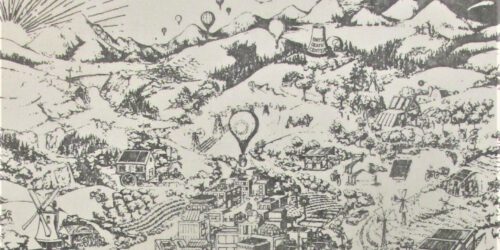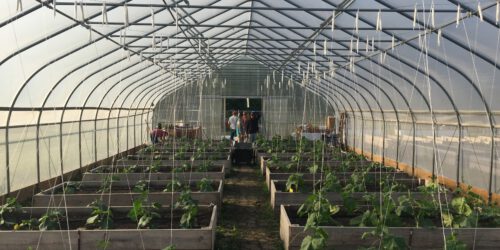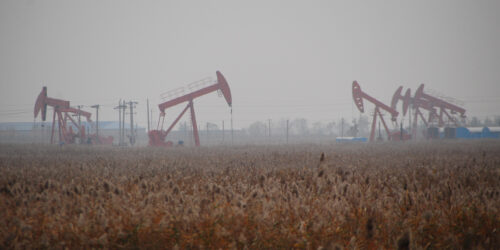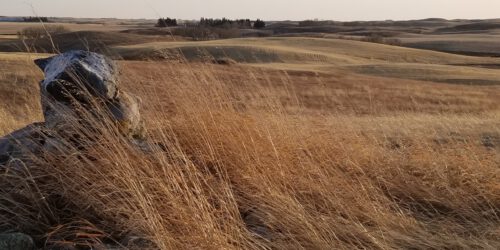Cycles of Use on the Landscape: Relationships for Long-Term Ecological Restoration Planning

This post by Tim Alamenciak originally appeared as part of a series on Environmental Histories of the Future on NiCHE, the Network in Canadian History & Environment.
Gnarled tree roots grip the foundation of the old Villa-by-the-Speed at Ignatius Jesuit Centre in Guelph, trying to reclaim the building for nature. The concrete is so worn the foundation could be mistaken for rocks. The slow-moving work is 60 years in the making.
The area was left to be overtaken by forest after the villa burned down in 1964. It has since been overtaken by young trees. The cycles of use and restoration are imprinted on this emerging landscape. The land is on the traditional territory of the Mississaugas of the Credit First Nation and was a part of the Between the Lakes Purchase of 1792. The Ignatius Jesuits, who opened the centre in 1913, have made a commitment to a restoration plan on the land for the next 500 years – a rare long-term commitment in the world of ecological restoration.

Time is an ally and opponent of ecological restoration. Every restorationist relies on time to execute their plans, but the long-term future of their work merits serious consideration – what will become of these projects in a hundred years? Two hundred years? Many projects are executed on five or ten-year timelines with little attention to the deep future of the site being restored. One major question for ecological restoration is whether the efforts put in today will be valued in decades or centuries.
The UN Decade on Ecosystem Restoration began in 2021 and calls for large-scale cultural change that lasts for centuries to come. To fulfill that ambitious promise, leading thinkers and practitioners in restoration need to grapple with the long-term future of their ecological interventions.
The Society for Ecological Restoration’s International Principles and Standards for the Practice of Ecological Restoration calls for “long-term” monitoring of projects, which it defines as 10 years or more. It sets out a particular understanding of ecological restoration that aims to reduce sources of degradation – chief among those being human activities. At the same time, the Principles and Standards aim to recreate undisturbed ecosystems. The challenge is that undisturbed ecosystems are historically rare. The landscape in Canada was heavily populated prior to colonization, with rich societies practicing agriculture, hunting and gathering.[1] In the language of the Principles and Standards, such practices are degradation.
The Jesuits’ 500-year commitment has as its goal restoring an old-growth forest on former agricultural land. Such a goal is based on the belief that old-growth forest is a climax ecosystem and an appropriate goal for restoration, but it omits the role of people and the history of the land. There is an implicit assumption that “nature” has historically been left to its own devices, which ignores the role of people in managing, harvesting and living on the landscape.

The notion that old-growth forests dominated Ontario is a colonial one. Historical accounts of Wendat, Neutral, Haudenonsaune, and Anishinaabeg peoples living in the area describe an active population of farmers, hunters and fishers, harvesting plants for food and medicine, clearing land for agriculture and felling trees for firewood.[2] The landscape was actively utilized and the notion of old-growth forest is based on a colonial reading of history that omits people. The solution instead is to seek to restore relationships as well as ecosystems.
In 2003, Eric Higgs wrote Nature by Design, a book that grapples with the challenges of restoration with humans as an ever-present force. “The point [of restoration design] is not to be an author of nature, but to create a narrative in which natural and cultural processes can write the text,” wrote Higgs.[3] This idea of narrative speaks to the importance of restoring relationships as well as ecosystems.
Our plans for the future of ecological restoration must engage honestly with history and include the role of people on the landscape in order to chart a clear path to the future. It is impossible to predict the future, but one thing that can be said with certainty is that the role of people on the landscape will likely increase. To restore with targets that see people as sources of “degradation” is to set projects up to fail.
J. Leighton Reid has tentatively approached the question of the future from a biophysical perspective by posing three time-related questions: How long do restored ecosystems persist? Why do some continue to accrue biodiversity benefits while others are converted to alternative land uses? How can we enhance the persistence of restored ecosystems? [4] I argue that an answer to all three of Reid’s questions lies outside of biophysical science: the key is relationship.
To their credit, the Ignatius Jesuit Centre does consider relationship. They are actively engaged with the local Anishinaabe community through a land-sharing agreement around a sweat lodge, a knowledge braiding education program and agricultural work.
The Anishinaabe, who previously stewarded the land on which Ignatius Jesuit Centre stands, have a teaching that calls for people to think seven generations into the future when making decisions. Robin Wall-Kimmerer writes of it beautifully in Braiding Sweetgrass as The Honorable Harvest: “They are rules of sorts that govern our taking, shape our relationships with the natural world, and rein in our tendency to consume—that the world might be as rich for the seventh generation as it is for our own.”[5]
Kimmerer writes of a concept that she calls reciprocal restoration. “Reciprocal restoration” she writes, “is the mutually reinforcing restoration of land and culture such that repair of ecosystem services contributes to cultural revitalization, and renewal of culture promotes restoration of ecological integrity.”[6]
Cultural revitalization is important to consider in ecological restoration because it can help ensure that restoration projects are successful in the future through restoring relationships to the land. The “how” of restoring relationship is an important, ongoing question in ecological restoration. There is a matrix of viable techniques, including community-led ecological restoration, environmental education and engagement in policymaking. One key approach to consider is the Indigenous Land Back movement.
Groups like 1492 Land Back Lane and O:se Kenhionhata:tie have been calling for the return of land to Indigenous peoples. Such a move should be seriously considered by ecological restoration practitioners as a way of ensuring the long-term stewardship of restored landscapes and meaningfully working towards reconciliation. It may mean letting go of the old-growth forest ideal, but it would be a step towards restoring relationships as well as ecosystems. The Ignatius Jesuit Centre’s 500-year commitment is a laudable example of the kind of long-term thinking necessary for ecological restoration, but the idea of the old-growth forest and so-called “undisturbed” restoration targets needs serious reconsideration. In order to take the future seriously, restorationists need to engage honestly with the past, including landscapes that were heavily populated prior to contact. In doing so, it will be possible to see clearly the role of relationship to the land and plan for change that may last for centuries to come.
[1] John L. Riley, The Once and Future Great Lakes Country: An Ecological History (Montreal & Kingston: McGill-Queen’s University Press, 2013)
[2] John L. Riley, The Once and Future Great Lakes Country: An Ecological History (Montreal & Kingston: McGill-Queen’s University Press, 2013), pp. 3-28
[3] Eric Higgs, Nature by Design: People, Natural Process and Ecological Restoration (Cambridge, Massachusetts: The MIT Press, 2003), pp. 289
[4] J. Leighton Reid, “Restoration Ecology‘s Silver Jubilee: big time questions for restoration ecology,” Restoration Ecology 26, no. 6 (2018): pp. 1029-1031. https://onlinelibrary.wiley.com/doi/abs/10.1111/rec.12883
[5] Robin Wall-Kimmerer, Braiding Sweetgrass: Indigenous Wisdom, Scientific Knowledge and the Teachings of Plants (Minneapolis, Minnesota: Milkweed Editions, 2015), 180.
[6] Robin Wall-Kimmerer, “Restoration and Reciprocity: The Contributions of Traditional Ecological Knowledge” in Human Dimensions of Ecological Restoration (Washington: Island Press, 2011), 258.
*Cover image: A cluster of Jerusalem Artichoke (helianthus tuberosus) growing in the meadow at Ignatius Jesuit Centre. Photo by author.






1 Response